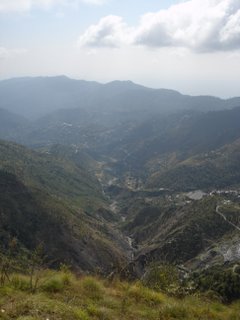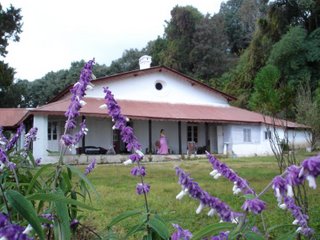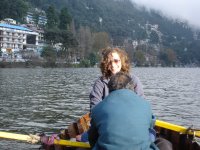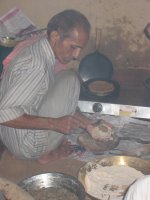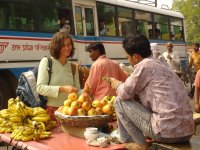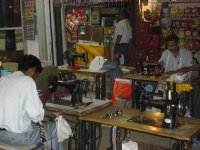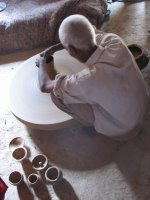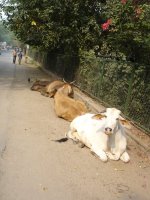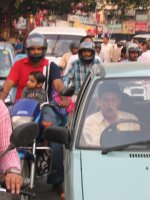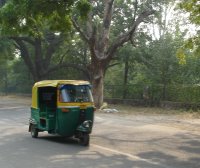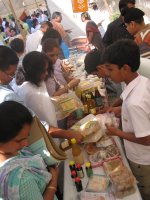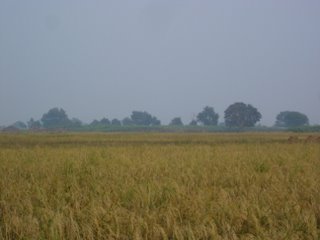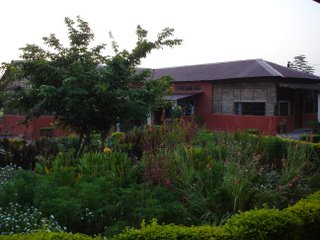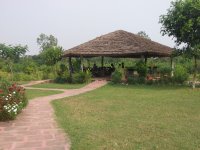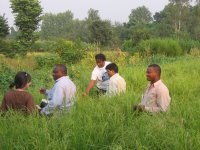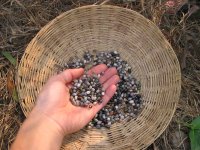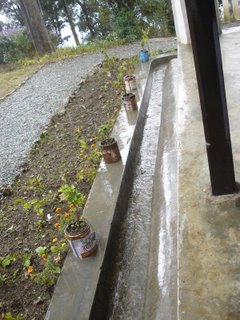Retreat with Satish Kumar- read a description of the retreat
hereSanskriti KendraViveka FoundationNovember 18-20, 2006
Satish Kumar, is the editor or Resurgence Magazine and in addition to teaching around the world, teaches at Schumaker College in England.

He joined the Jain monkhood at the age of nine and left it at twenty to become a follower of Ghandi (who subscribed to no religion and therefore was inconsistent with Jainism). A few decades ago, he walked 6,000 miles without any money through the middle east, Russia, Europe, and the US to protest nuclear arms. He is a ghandian scholar though he has never attended one day of schooling.
Each morning, Satishji led a meditation that took place outside, under a wooden structure, where we sat in a circle on wooden mats.
Meditation:
·Bow to the great spirit and give thanks
·Shant OM (AUM) three times
·There are two kinds of movement in the body: the breath and the mindà harmonize
·The breath which sustains you sustains all life
·In meditation, we connect with the breath of life
·Gaiya in Greek is earth. In Sanskrit, it means universe. Gita means song.
·Life and the universe is a song in fluid motion, constantly changing
·Shanty means peace
·Say peace three times for peace in myself, peace in the world, and peace in the universe
·OM (AUM) SHANTI SHANT SHANTI
·Bow to the great spirit and give thanks
A workshop for the purpose of revujenating the self for those who do social work.
Prejudice of Ownership

Satishji opened by discussing the nature of social work. Work to help others. But actually social work to help yourself. We have a prejudice of ownership such that those who are "trying to help" are imprisoned by ownership of nature.
Separation= I know, I have, I will give
He discussed the nature of relating. All things have a relationship. Without a relationship, there is fear, anger, and other negative emotions.
Relationship= spiritual practice, sharing
·Become free by giving up ownership; this is not work, it is a way of life
·Giver and receiver is the same
·No end purpose, just BE
·The oppressed will not be liberatred until oppression is liberated
·We are imprisoned by idealism
Everything is a Process
·The moment you are fixed, you are no longer gaiya
·In a relationship, everything is there and you will respond appropriately by listening to your inner voice
·Swim with the current
·Use courage to release crativity within
·Undaming the flow of life
·A protest is action without goal of achievement, unattached to outcome
·Face the problem, there are no solutions
·It's all just a process
Vinoba traveled through India taking donations of land for the poor, landless. He worked with everyone (rich and poor-- nobody is a bad guy), equally and without discrimination.
Swadharma= your own dharma
·cultivate seeds, flowers, and fruits in our beings garden
·weed out the fear, greed, etc.
Dooka=pain; first noble truth
·when we understand how we brought pain to ourselves, we can deal with it
·whatever brought the pain is the cause of pain
Satya Graha= insistence on truth; civil disobedience
·must be practiced by someone living a balanced, pure life
·inclusive by spiritual obedience
Soul= dynamic composition; invisitable, constantly changing with continuity, individualized by universal
The 3 Concepts: SOIL, SOUL AND SOCIETY
Seeks answers and they will come
Find your switch
Maintain awareness to stay on the path
Definitions:
Dillusion- work of the mind
Enlightenment- is beyond the mind, includes the entire universe
Dharma- what holds us, what sustains us; patience has the same root
Bhakti- devotion
Violence- violating with dominating control; engage in struggle with violence world
Anekant- not one truth
Saduad- not the whole truth because language is dualistic; the moment a truth is spoken, something is lost by the very process of verbalizing it
Educare- to bring out
Transcendence- beyond the sphere of intellect
Recommended reading:
"Talks on the Gita" by Vinoba
 “Vigyan” means ‘Search of Truth’ and “Ashram” symbolises ‘Simple living and High thinking for us, a organization where all are equal. Started in 1983 by the late Dr. Kalbag, his wife, Amma, is still there teaching today. She welcomed me to Vigyan Ashram after it was recommended by a friend from Mumbai. The school uses a radically different approach than the traditional, classroom style of Western education. Instead, it relies upon hands-on learning as the foundation for progress and understanding. The students who attend are "drop-outs" i.e. those who have been pushed out of the educational system (80% by the 10th grade). While here, the students grow food, poultry, build housing (including all buildings on the campus), furniture, and create their own innovations. They also conduct water well prospecting and have a M.I.T.-sponsored computer technology laboratory. When I was there, they were working on building a pedal-powered charger for flourescent light bulbs so that local village homes can have a few hours of light each day. Currently, there are 8-10 hour blackouts during the day due to the electrical drain of the IT industry from surrounding cities of Pune and Mumbai.
“Vigyan” means ‘Search of Truth’ and “Ashram” symbolises ‘Simple living and High thinking for us, a organization where all are equal. Started in 1983 by the late Dr. Kalbag, his wife, Amma, is still there teaching today. She welcomed me to Vigyan Ashram after it was recommended by a friend from Mumbai. The school uses a radically different approach than the traditional, classroom style of Western education. Instead, it relies upon hands-on learning as the foundation for progress and understanding. The students who attend are "drop-outs" i.e. those who have been pushed out of the educational system (80% by the 10th grade). While here, the students grow food, poultry, build housing (including all buildings on the campus), furniture, and create their own innovations. They also conduct water well prospecting and have a M.I.T.-sponsored computer technology laboratory. When I was there, they were working on building a pedal-powered charger for flourescent light bulbs so that local village homes can have a few hours of light each day. Currently, there are 8-10 hour blackouts during the day due to the electrical drain of the IT industry from surrounding cities of Pune and Mumbai.






















